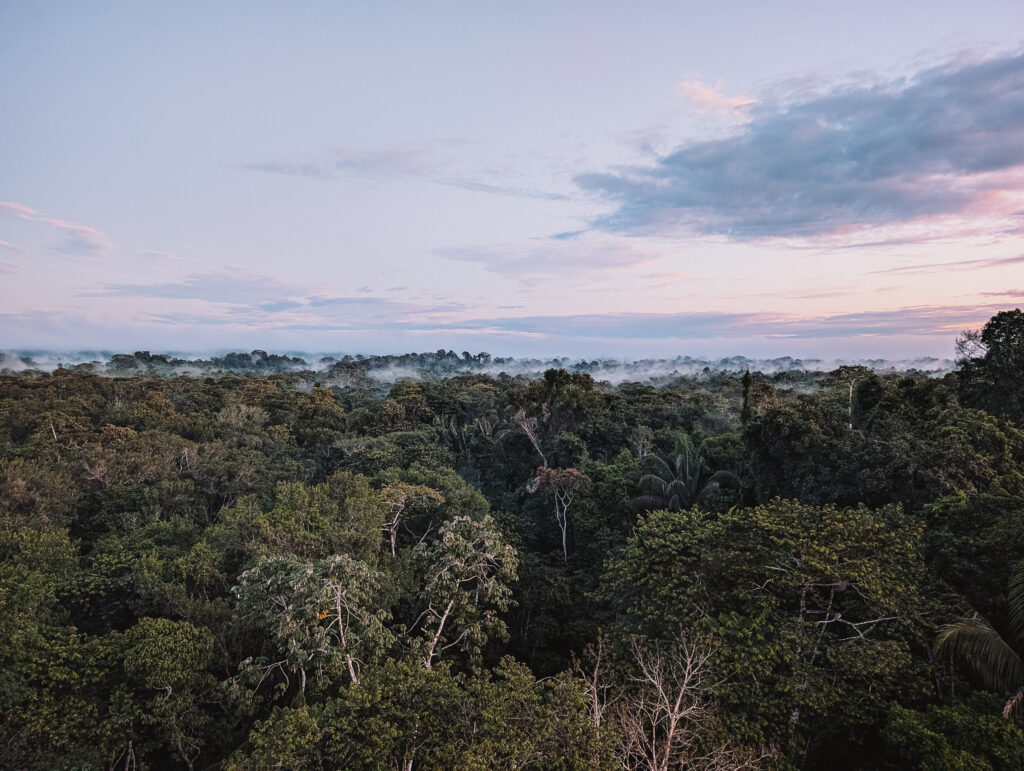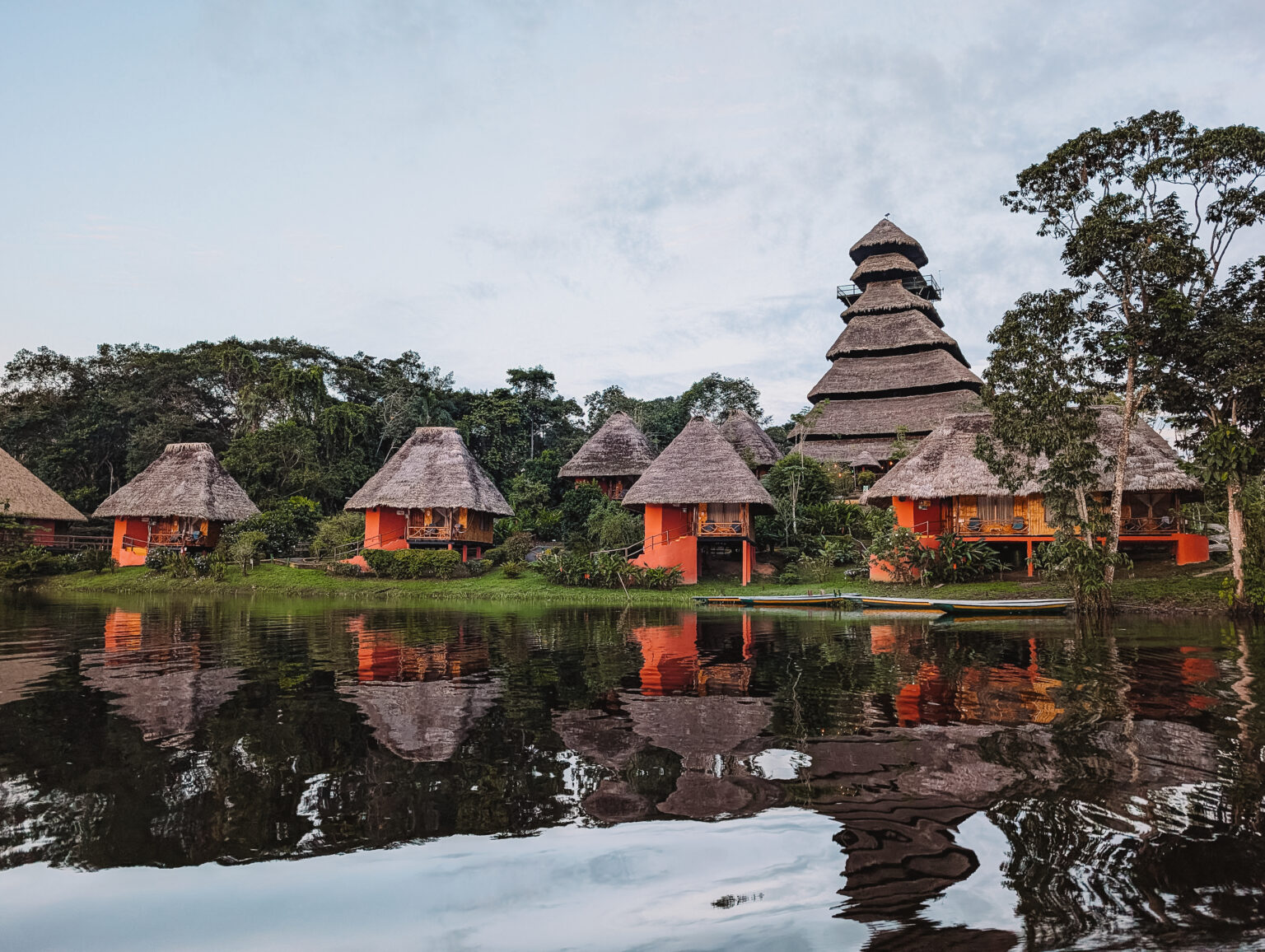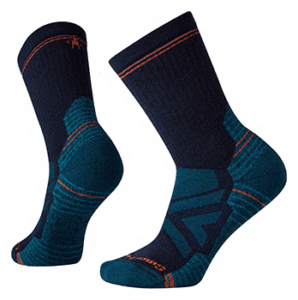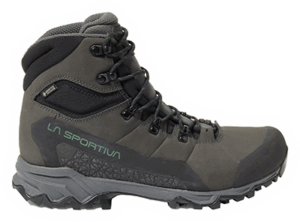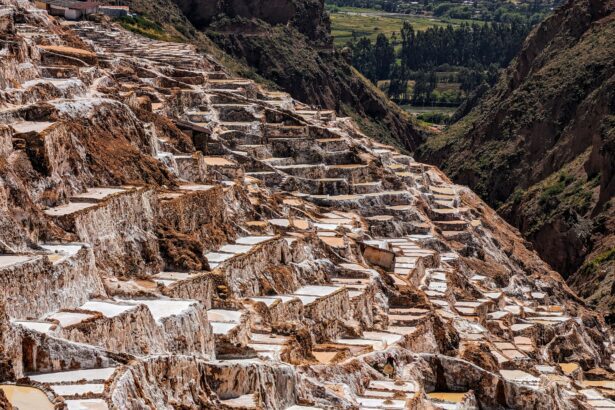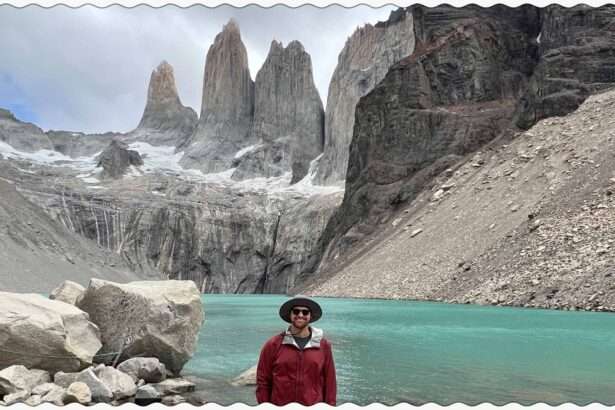The Napo Wildlife Center Ecolodge is a luxury resort deep within the Amazon Rainforest of Ecuador. It stands out from some of the other ecolodges in Ecuador for the following reasons:
- Napo Wildlife Center Ecolodge is owned and operated by the local Kichwa Añangu community, an indigenous community who has fully dedicated themselves to conserving their land and the rainforest property that has been dedicated to them.
- The lodge is the only one located within Yasuni National Park. This means that there are more opportunities to see animals because they feel safer within land that is heavily protected. In addition, you have to take a two hour motorized canoe to a 2 hour paddled canoe to get to the lodge. Because of its remote location, it is easier to spot some incredible animals within the rainforest.
- The structures of Napo Wildlife Center Ecolodge are constructed with the techniques of the local indigenous community and uses the natural resources within the rainforest in a sustainable way, integrating the lodge seamlessly with beauty of the jungle and celebrating local knowledge and skill.
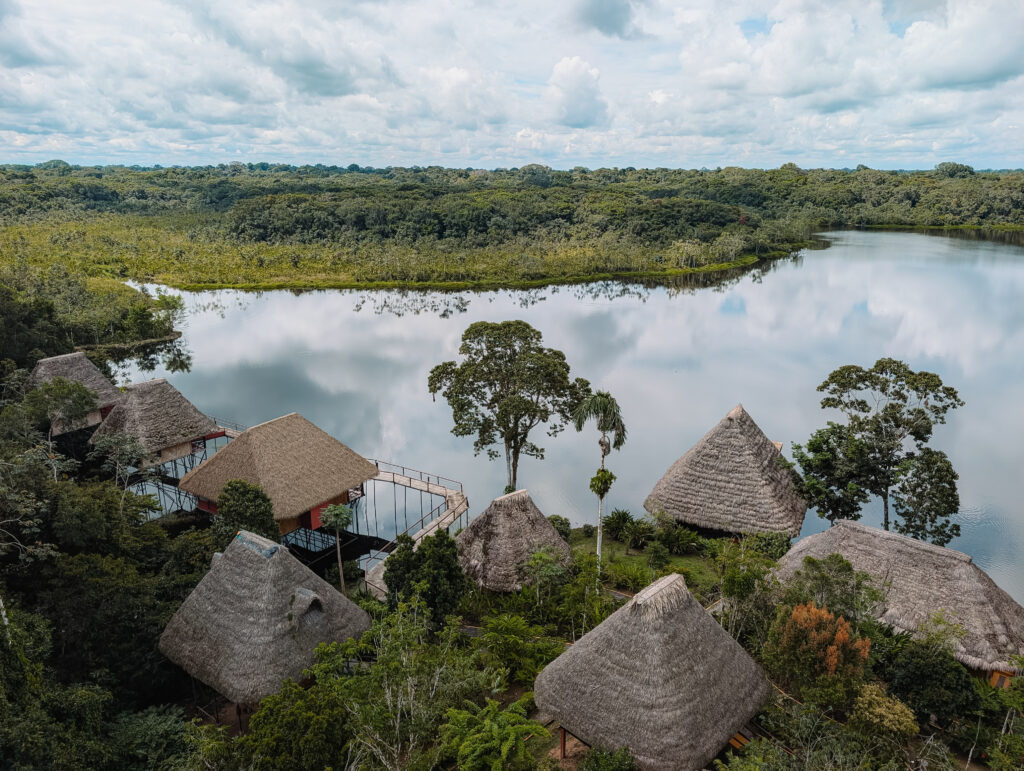
Blueprint Travelers Recommendation: Napo Wildlife Center Ecolodge
A Quick History of the Napo Wildlife Center Ecolodge
The Napo Wildlife Center Ecolodge has been operating for 25 years. With the dedication to an ecolodge, the community has completely stopped hunting within their land and they have seen an incredible regrowth and rehabilitation of the ecosystem within their land. For example, today there are otters swimming in their waters, something that had disappeared before their environmental efforts.
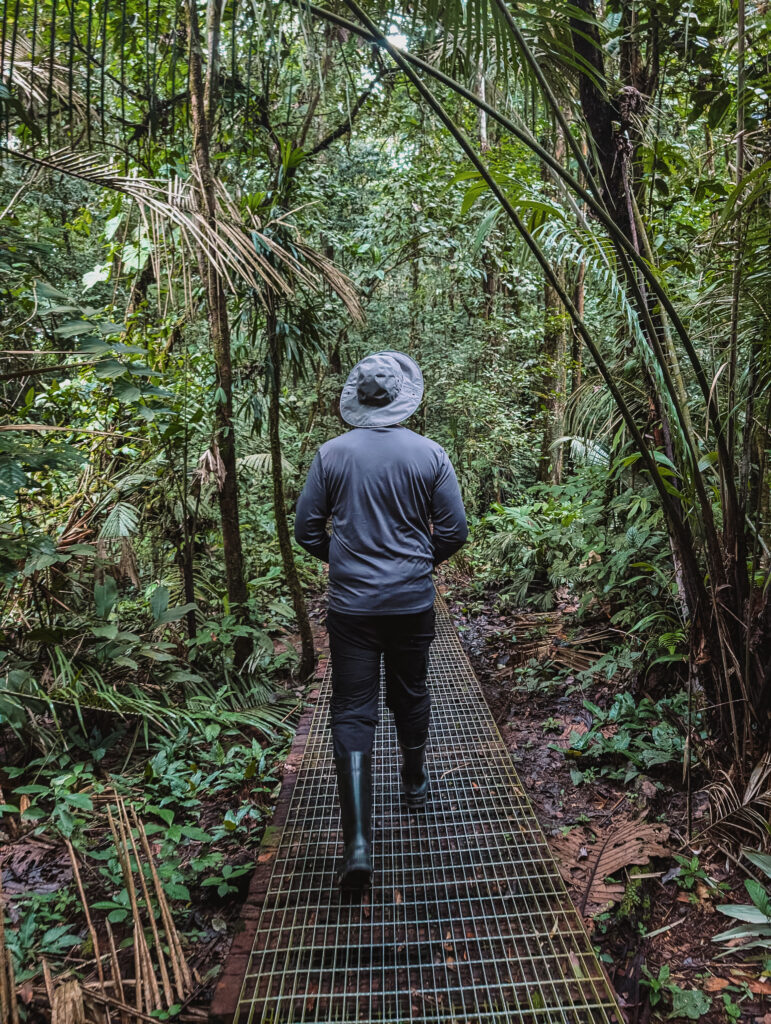
With the profits that they acquired from their first lodge, the Kichwa Añangu community built their second lodge within their own community. The Napo Cultural Center is an ecolodge that focuses on the rainforest nature while connected with the Añangu indigenous community. To get to this lodge, you just have to take the two hour motorized canoe to the lodge. It is also more approachable in price than the Napo Wildlife Center.
Each of these lodges employ their community, bringing in a sustainable income and creating jobs for a community that did not want to sacrifice their natural resources. In addition, they have been able to invest in the education of their children with an elementary and high school, which teach the students English and other tourism skills to prepare them for their future careers within the lodge. They even have community members who are official tour guides at the different lodges, a job that requires a university degree in Ecuador. And with the profits from both of these lodges, the community is planning a third lodge to continue to grow the employment opportunities for their community.
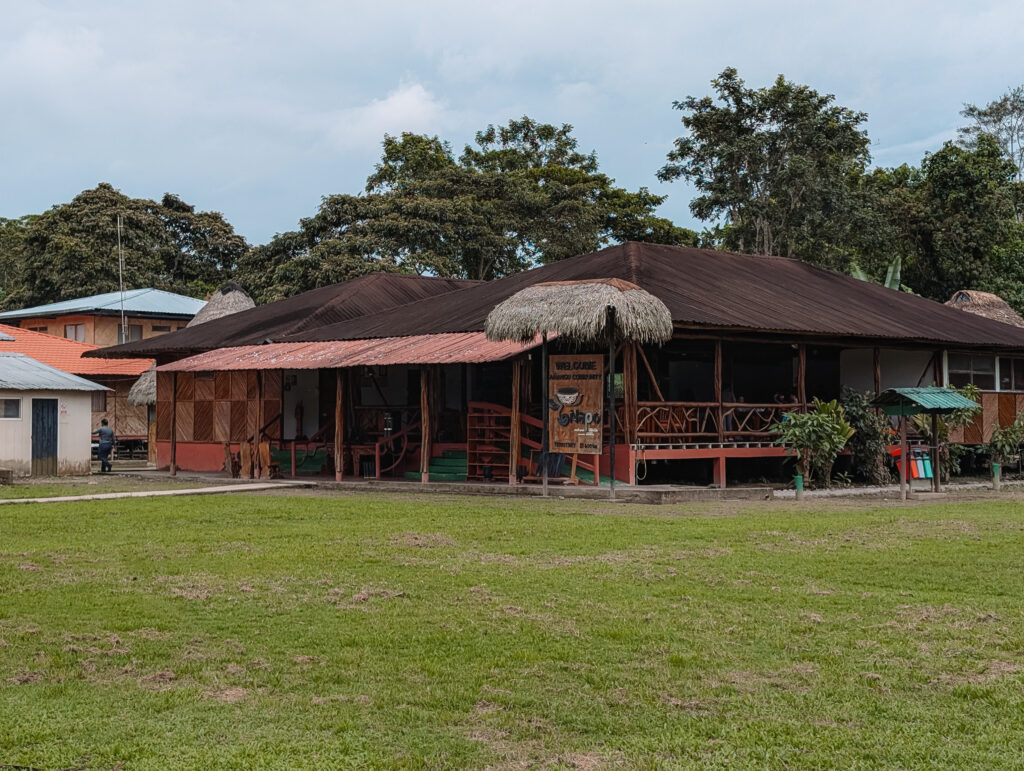
Why SHould You Visit the Amazon Rainforest?
The Amazon Rainforest is the largest rainforest in the world and considered the lungs of the Earth. It is spread across 9 countries, including Brazil, Bolivia, Peru, Ecuador, Colombia, Venezuela, Guyana, Suriname, and French Guiana and is anchored by one of the largest rivers in the world, the Amazon river. While the rainforest can be visited from any of the countries listed, it is important to do research into how you are visiting this incredible ecosystem. (We recommend visiting the Ecuador Amazon Rainforest with Napo Wildlife Center because of our evaluation of their sustainability and cultural priorities.)
The Amazon Rainforest is one of the most ecologically diverse places in the world. It is dense with a variety of flora and fauna, much of which is endemic to this ecosystem. The rainforest is full of life in a carefully balanced ecological environment. It must be protected both because of its importance to the survival of the Earth but also because it is overflowing with delicate life. There are more species of animals in the rainforest than anywhere else in the world; however, there just aren’t many of each species. So no matter where you choose to visit the rainforest, if you go to an ecologically sustainable area, you will see a large variety of flora and fauna!

A Sample Napo Wildlife Center Itinerary
Experiences with the Napo Wildlife Center start with 4 days/3 night all-inclusive tour as their shortest option and can always be extended to give you more opportunities to see a diversity of animals. The reason that the experience has a 4 day minimum is because the first and last day of the experience are dominated by transportation to and from Quito. In fact, to get between Quito and the lodge, it takes a flight, a 2 hour long motorized canoe ride, and a 2 hour long paddled canoe ride.

With the 4 day experience, you have the opportunity to see monkeys, parrots, sloths, snakes, caiman, frogs, toucans, other birds, otters, and more! Staying for longer allows you more time and chances to see different animals. You can also hire specialized guides to help you if you are interested in bird-watching or wildlife photography. These additional guides can help support your goals in your travels to the rainforest. You will attend the different tours and experiences with the other people who arrive at the lodge on the same day as you, unless you choose a private experience. However, even in a group experience, the groups are kept small to prioritize opportunities to see wildlife in the various excursions.
A Sample Itinerary
AM
PM
Day 1
Fly from Quito, Ecuador to Coca, Ecuador
Transfer from airport to Napo River
Motorized canoe into Yasuni National Park – lunch is provided on the canoe
Transfer to paddled canoe and search for wildlife from the canoe
Arrive at Napo Wildlife Center + Welcome
Get settled in your accommodation
Briefing about the Napo Wildlife Center experience
Dinner
Get fitted for rubber boots
Day 2
Breakfast
Take a paddled canoe to a transfer point where you will get into a motorized canoe to visit the first parrot salt lick
Walk through the rainforest to the second parrot salt lick and wait for parrots to arrive
Visit the Kichwa Añangu community (read more below)
Return to transfer point with motorized canoe where you will have lunch
Take a paddled canoe back to the Napo Wildlife Center ecolodge
Relax at the lodge
Dinner
Night walk behind the lodge to see the rainforest’s night animals
Day 3
Breakfast
Take a paddled canoe to a landing and hike into the rainforest to an observation tower
Wait at observation deck to watch all the animals waking up in the morning
Walk through the rainforest and learn about different medicinal plants from local indigenous people
Take the paddled canoe back to the lodge for lunch
Relax at the lodge for a few hours
Go on a paddled canoe excursion through the different creeks around the lodge to see more animals
Watch movie about the history of the Napo Wildlife Center
Dinner
Day 4
Early wake up
Take a paddled canoe to the transfer point and transfer to a motorized canoe – breakfast is provided on the canoe
Take a van to transfer from the Napo River to the airport in Coca
Fly from Coca, Ecuador to Quito, Ecuador
Visiting the Kichwa Añangu Indigenous Community
All experiences with Napo Wildlife Center include a visit to the Kichwa Añangu community that owns and operates the ecolodge. By visiting the Napo Wildlife Center, you are committing to supporting and uplifting this community. Here, the women of the community will show you different parts of their culture, diet, and lifestyle. When the lodge was initially constructed, all people from the community would work at the lodge. However, they found that there was no one in the community to watch their children. Today, it is mostly the men of the community who work at the lodge.
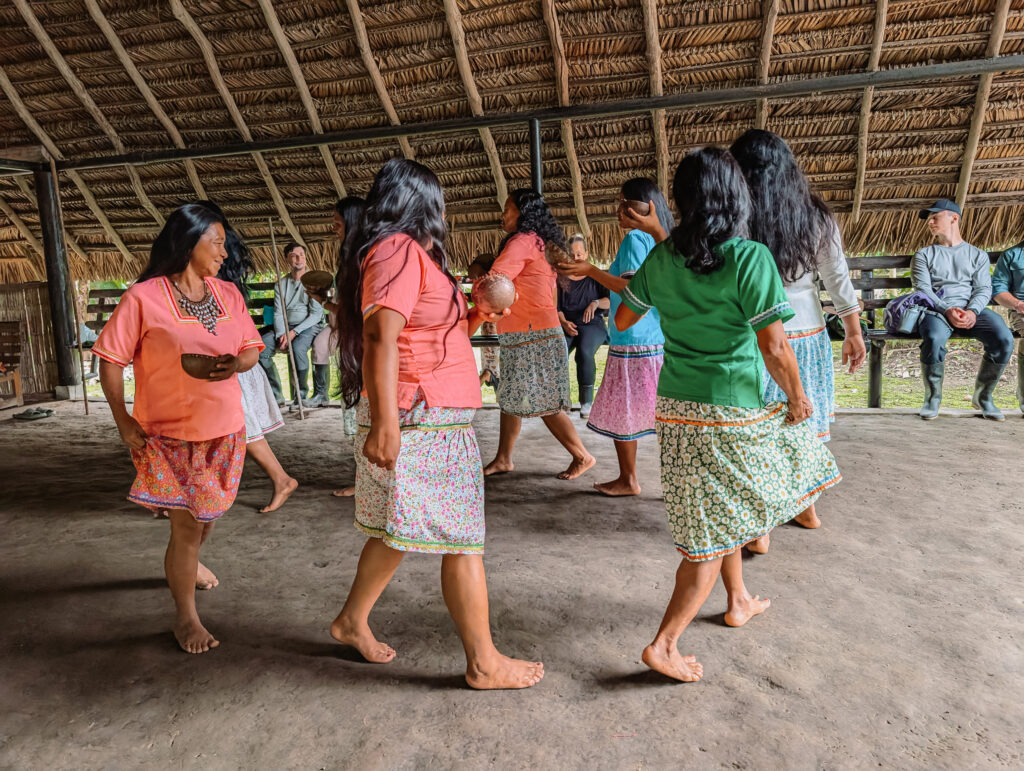
Instead, the women started their own efforts within the community to highlight their culture to visitors. They have even constructed a few structures in the center of the community to support this mission. The first structure shows traditional building techniques and is a large space where the women invite you to participate in a traditional welcome dance with them. The second building is a recreation of a traditional home where the women show how they have used the resources of the rainforest to support their lives, from making cookware and baskets to the weapons that they used to hunt before becoming an ecological center. While they show you these different skills, other women of the community prepare some of their traditional foods that you will have the opportunity to sample.
Finally, the last structure is a small boutique where the women sell their own artisanal crafts, including pottery and jewelry. Make sure to bring some cash because this is a great occasion to get local souvenirs and support the beautiful crafts of this community. Overall, these efforts allow them to continue to raise their children while contributing to their goal of preserving their community and the local environment for everyone to enjoy. The ecolodge’s mission has created opportunities for all the members of the community.
When Is the Best Time to Visit the Amazon Rainforest in Ecuador?
There really is no bad time to visit the Ecuadorian Rainforest. The temperature and rainfall has very little variance throughout the year and there are no migration patterns within the rainforest that would affect your experience. The “rainier” season of the rainforest falls between March and July (although it often rains in the rainforest). The temperature typically maintains around 77°F (25°C) around the year but can reach 104°F (40°C) during the dry season. No matter when you go to Ecuador, you can always visit the rainforest and see the plethora of wildlife in this part of the world.

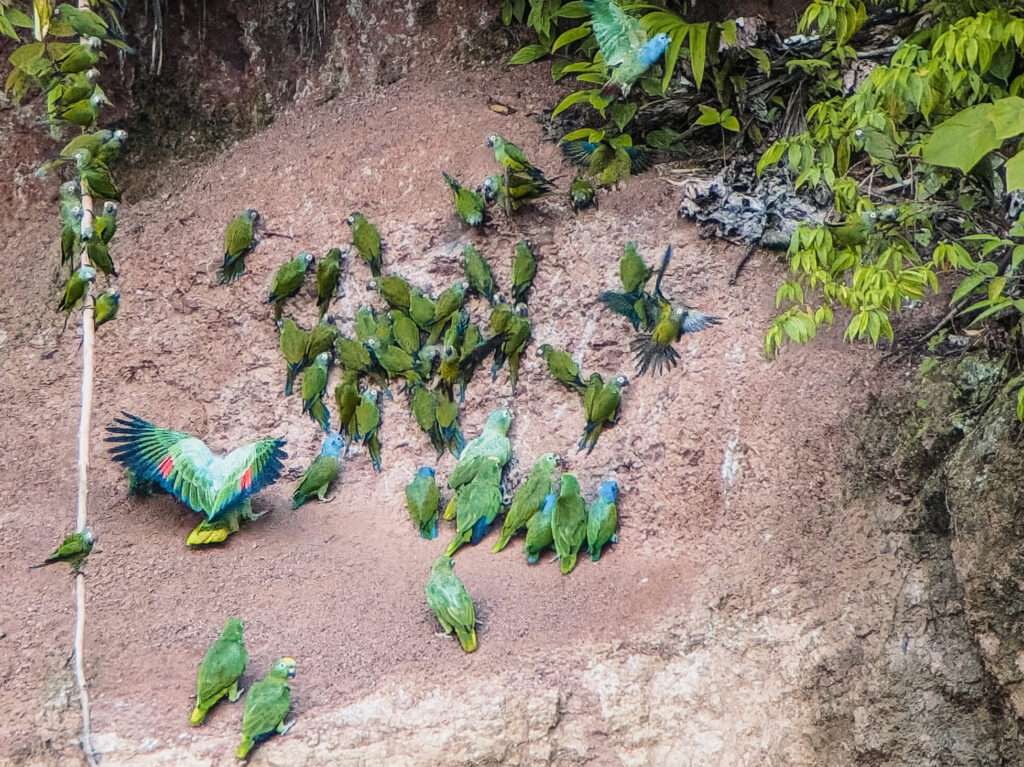
Your Guides for Your Napo Wildlife Center Experience
No matter what experience you choose, you will have a wildlife guide, a cultural guide, and a paddler to support your trip. The wildlife guide is an English-speaking national park tour guide and is specialized in knowing the different species of flora and fauna in the region. These guides are often from different indigenous communities within the Ecuadorian Amazon Rainforest and understand the culture and lifestyle within this ecosystem. They are also incredibly skilled and knowledgeable in finding hidden animals in the forest.
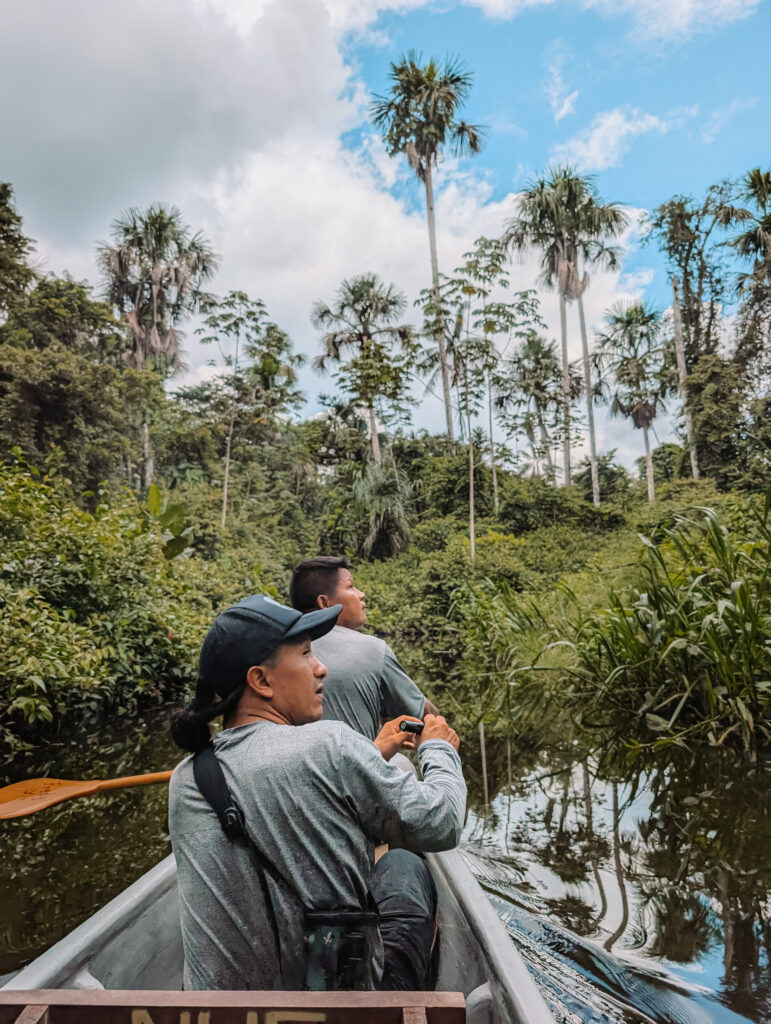
The cultural guide is someone from the Kichwa Añangu who adds a layer of cultural knowledge to the experience. Some are former hunters with strongly honed skills and senses to detect, see, and hear different wildlife. Today, these hunters can continue to use these impressive skills to spot wildlife for visitors and pass down these skills to their children so they too can continue to maintain the skills of their ancestors while providing for their future as guides in the rainforest. The cultural guide also helps explain the medicinal and practical use of different plants throughout the rainforest for their community. (While they have a doctor today, thanks to the efforts of the ecolodge, they continue to use the ancient medicinal practices of their ancestors as much as possible.)
The paddler is also a member of the Kichwa Añangu community. They both paddle the canoe (along with the wildlife and cultural guide) and help spot different wildlife along the different creeks around the ecolodge. They are a vital part of the team that helps make the experience incredibly unique and special.
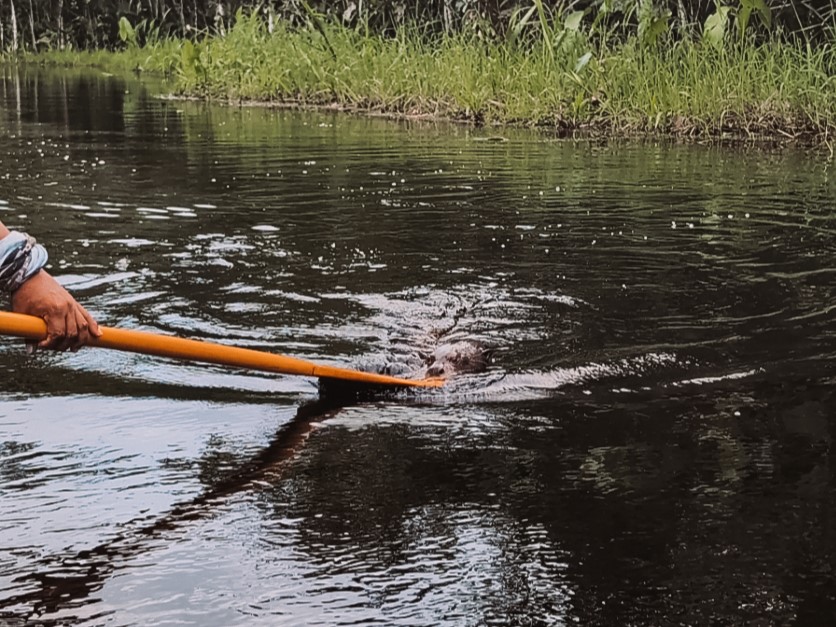

The Napo Wildlife Center is an all-inclusive experience (except for alcoholic drinks) and the staff helps make sure that the experience is wonderful. Every meal is provided by chefs of the community, typically in a buffet style that includes a soup, different proteins and vegetables, and some fruit and dessert. The lodge also continuously maintains the rooms, even helping pull down the mosquito nets around the bed to sleep (even though we did not find that there were many mosquitos during the month of July in the rainforest).
It is really all the people of the Napo Wildlife Center that make the experience in the Amazon Rainforest truly one-of-a-kind and extraordinarily special.
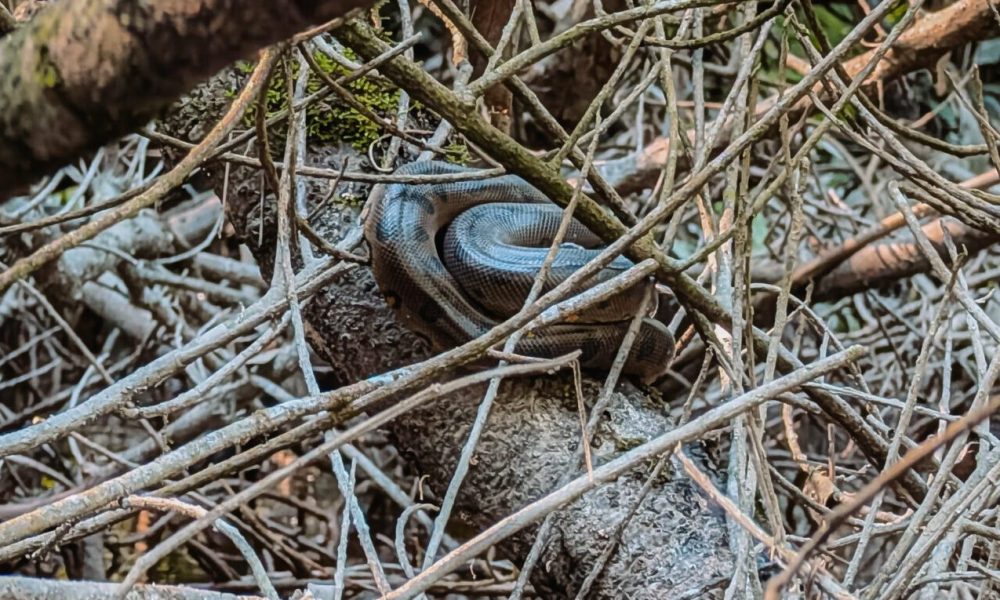
The Blueprint Travelers Jungle Staples
The Napo Wildlife Center Ecolodge Itself
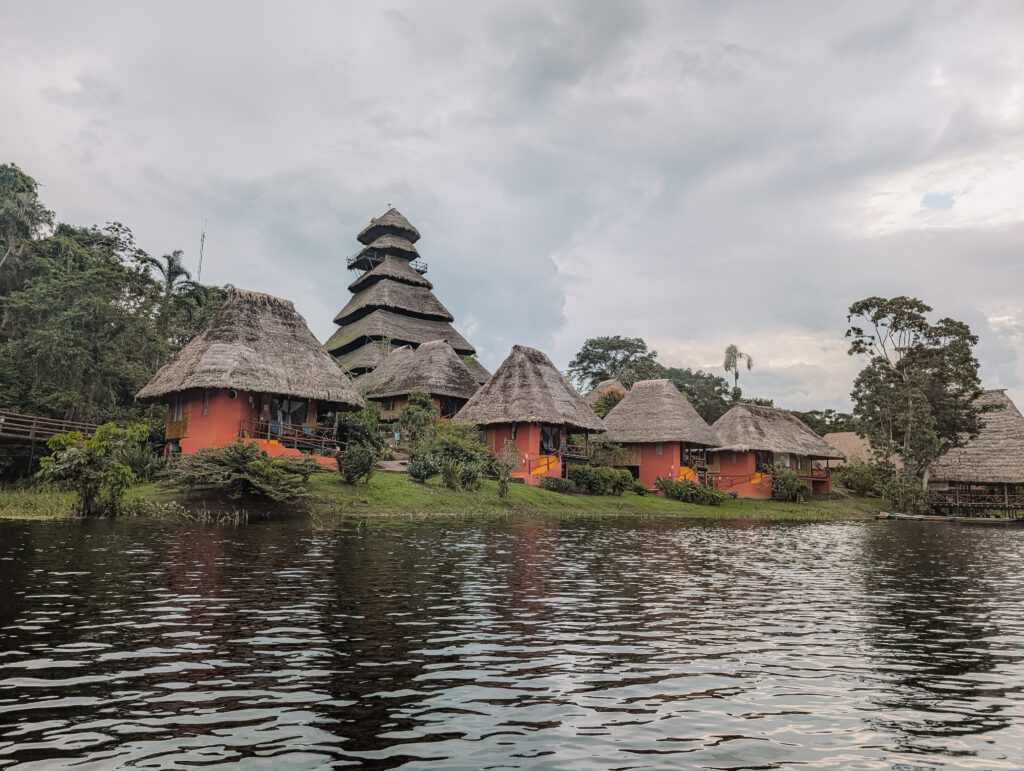
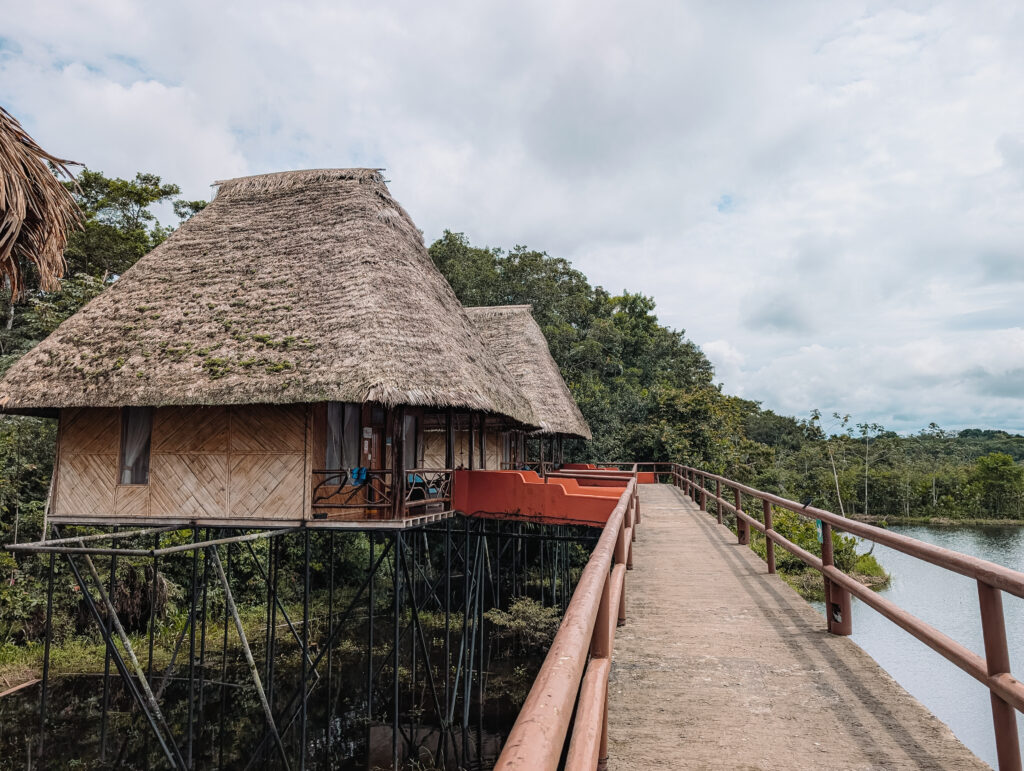
The final section of the property includes two different types of lodges for your accommodations during your time at the ecolodge: the standard cabin and the suites. The standard cabins are scattered around the property and many have views of the lake. The suites are larger cabins that are propped above the edge of the water of the lake. These include a glass floor with a seating area so you can watch the fish and wildlife below from your room, a private hot tub in the back of the cabin with views into the rainforest, and hammocks on the front of the cabin where you can relax and look out over the lake.
Overall, the ecolodge is beautiful, using the building techniques of the local Kichwa Añangu community to maintain the cultural identity of this location. There is a sense of peaceful yet environmentally-friendly luxury that is perfect for a 4+ day experience in the Ecuadorian Amazon Rainforest.
